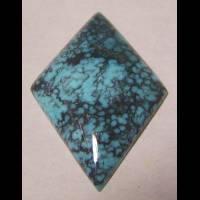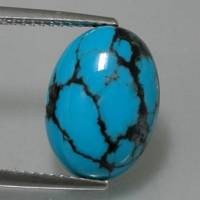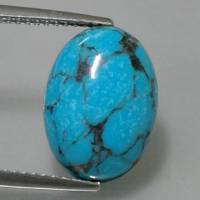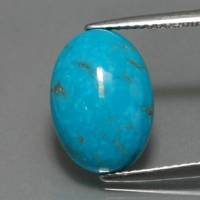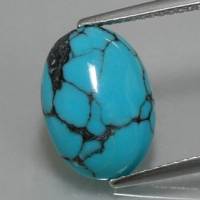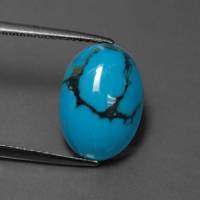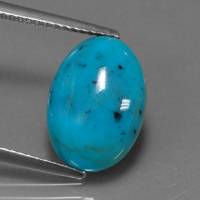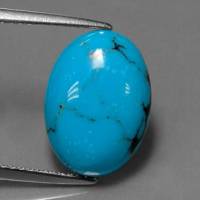Turquoise

Arizona, USA
47.74 carats
© Brian Kosnar - Mineral Classics
Turquoise is opaque sky-blue, blue-green or apple-green stone with brown, dark gray, or black veins of other minerals or the host rock. It can also be intergrown with malachite and chrysocolla.
Turquoise Gemstones by Colour
This table shows the variety of hues this gemstone can be found in. Click on a photo for more information.
Turquoise Gemstones by Size
This table shows distribution of Turquoise gemstone sizes that are listed on this site. This can give a good indication as to the general availability of this gemstone in different sizes.
Contributed photos
Lightest:2.04 cts
Heaviest:47.74 cts
Average:7.03 cts
Total photos:23
Do you have a larger Turquoise? Why not upload a photo?
| General Information | ||||||||||||||||||||||||||||||||||||||||||||||||||
|---|---|---|---|---|---|---|---|---|---|---|---|---|---|---|---|---|---|---|---|---|---|---|---|---|---|---|---|---|---|---|---|---|---|---|---|---|---|---|---|---|---|---|---|---|---|---|---|---|---|---|
| Chemical Formula |
| |||||||||||||||||||||||||||||||||||||||||||||||||
| Turquoise Treatments | ||||||||||||||||||||||||||||||||||||||||||||||||||
| Commonly impregnated with wax to enchance color or plastic to increase durability: SG on low side, hot pont test, scratch test. May be dyed: color concentration along fractures. Acetone may reveal the dye if not coated. Zachery treatment tests limited. Porosity reduced: doesn't absorb liquids unlike most untreated natural stones, doesn't "discolor" in water. High quality polish. Even (strong) coloration, color concentration diffused along fractures - Blue Chart Gem Identification, Herve Nicolas Lazzarelli, 2010, p 5 | ||||||||||||||||||||||||||||||||||||||||||||||||||
| Turquoise Simulants | ||||||||||||||||||||||||||||||||||||||||||||||||||
| Dyed howlite, dyed magnesite, variscite - Blue Chart Gem Identification, Herve Nicolas Lazzarelli, 2010, p 5 Glass can be used as imitation, but it can be identified by the luster of the small fractures on these pieces of opaque blue glass. - GIA, 2018 | ||||||||||||||||||||||||||||||||||||||||||||||||||
| Synthetic Turquoise | ||||||||||||||||||||||||||||||||||||||||||||||||||
| Synthetic magnification: granular structure - "fish-eggs", "cream-of-wheat". May show black "spiderweb matrix" (rounded pattern). Strong transmitted light: usually translucent - Blue Chart Gem Identification, Herve Nicolas Lazzarelli, 2010, p 5 | ||||||||||||||||||||||||||||||||||||||||||||||||||
| Physical Properties of Turquoise | ||||||||||||||||||||||||||||||||||||||||||||||||||
| Mohs Hardness | 5 to 6, Blue Chart Gem Identification (2010) More from other references | |||||||||||||||||||||||||||||||||||||||||||||||||
| Specific Gravity | 2.30 to 2.90, Blue Chart Gem Identification (2010) More from other references | |||||||||||||||||||||||||||||||||||||||||||||||||
| Cleavage Quality | None, Gemstones of the world (2001) More from other references | |||||||||||||||||||||||||||||||||||||||||||||||||
| Fracture | Conchoidal, Gemstones (2009) | |||||||||||||||||||||||||||||||||||||||||||||||||
| Optical Properties of Turquoise | ||||||||||||||||||||||||||||||||||||||||||||||||||
| Refractive Index | 1.610 to 1.650, Blue Chart Gem Identification (2010) More from other references | |||||||||||||||||||||||||||||||||||||||||||||||||
| Optical Character | Biaxial/+, Gemmological Tables (2004) More from other references | |||||||||||||||||||||||||||||||||||||||||||||||||
| Birefringence | 0.040, Blue Chart Gem Identification (2010) More from other references | |||||||||||||||||||||||||||||||||||||||||||||||||
| Pleochroism | Absent, Gemstones of the world (2001) | |||||||||||||||||||||||||||||||||||||||||||||||||
| Dispersion | None, Gemstones of the world (2001) | |||||||||||||||||||||||||||||||||||||||||||||||||
| Colour | ||||||||||||||||||||||||||||||||||||||||||||||||||
| Colour (General) | Light blue, bluish-green, green, greenish-blue, Gemmological Tables (2004) Commonly with brownish or black veinsMore from other references | |||||||||||||||||||||||||||||||||||||||||||||||||
| Colour (Chelsea Filter) | No reaction, Blue Chart Gem Identification (2010) | |||||||||||||||||||||||||||||||||||||||||||||||||
| Causes of Colour | Blue, Cu2+ in octahedral coordination, Pragmatic Spectroscopy For Gemologists (2011) | |||||||||||||||||||||||||||||||||||||||||||||||||
| Transparency | Translucent,Opaque, Blue Chart Gem Identification (2010) Strong transmitted light: appears opaque to semi-translucentMore from other references | |||||||||||||||||||||||||||||||||||||||||||||||||
| Lustre | Waxy,Dull (Earthy), Gemstones (2009) | |||||||||||||||||||||||||||||||||||||||||||||||||
| Fluorescence & other light emissions | ||||||||||||||||||||||||||||||||||||||||||||||||||
| Fluorescence (General) | Weak; green-yellow, light blue, Gemstones of the world (2001) More from other references | |||||||||||||||||||||||||||||||||||||||||||||||||
| Fluorescence (Long-Wave UV) | Inert to moderate whitish blue, Blue Chart Gem Identification (2010) | |||||||||||||||||||||||||||||||||||||||||||||||||
| Crystallography of Turquoise | ||||||||||||||||||||||||||||||||||||||||||||||||||
| Crystal System | Triclinic, Blue Chart Gem Identification (2010) More from other references | |||||||||||||||||||||||||||||||||||||||||||||||||
| Habit | Fine-grained, massive aggregate, partly as nodules or botryoidal groups, Gemmological Tables (2004) More from other references | |||||||||||||||||||||||||||||||||||||||||||||||||
| Inclusions in Turquoise | ||||||||||||||||||||||||||||||||||||||||||||||||||
| May contain inclusions of pyrite, calcite, etc - Blue Chart Gem Identification, Herve Nicolas Lazzarelli, 2010, p 5 | ||||||||||||||||||||||||||||||||||||||||||||||||||
| Further Information | ||||||||||||||||||||||||||||||||||||||||||||||||||
| Mineral information: | Turquoise information at mindat.org | |||||||||||||||||||||||||||||||||||||||||||||||||
| Significant Gem Localities | ||||||||||||||||||||||||||||||||||||||||||||||||||
| ||||||||||||||||||||||||||||||||||||||||||||||||||

